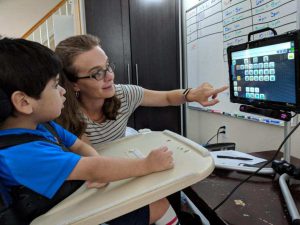 Last week I wrote about the importance of the motor planning piece in how Joey learns to communicate on his LAMP communication device. While the motor planning aspect is what currently fascinates me the most, it is only one aspect of why the LAMP treatment works to teach communication. My post last week also left me with other brief thoughts to share.
Last week I wrote about the importance of the motor planning piece in how Joey learns to communicate on his LAMP communication device. While the motor planning aspect is what currently fascinates me the most, it is only one aspect of why the LAMP treatment works to teach communication. My post last week also left me with other brief thoughts to share.
Other Aspects of LAMP Methodology:
Another aspect in the LAMP methodology is that it is a Speech-Generating Device (SGD). Once a word is selected the device produces the word so that the user receives auditory feedback. This feedback, paired with the motor planning, allows the user to build patterns of communication. The LAMP system is also built around core vocabulary.
LAMP Increasing Shared Engagement:
Shared engagement occurs when two or more people are attending to the same stimuli, while also engaging with one another. In a crowded movie theater we may be engaged in the same movie as the stranger sitting next to us, but we don’t have a shared engagement with that stranger. That engagement occurs when we begin whispering about the movie back and forth to the friend we came with. For infants, this shared engagement occurs when they stare into their mothers’ eyes while eating, and much of our social-emotional and cognitive development is built off our ability to share attention with another person.
This is important to consider when we are thinking about how we will teach communication, because it is possible to talk to another person to demand a snack or a preferred toy without joining into meaningful shared engagement with them. In the 2013 study I recently read, it is notable that the results not only show that LAMP therapy increased the child’s receptive and expressive communication, but that all participants showed an increase in their ability to maintain engagement and share attention, and a decrease in the users’ difficult behaviors. The AAC device gave the participants a way to communicate and engage with the world around them.
Will AAC Limit Future Speech Production?
Last week I also mentioned that my first impulse was to reach touch the words on Joey’s device before I orally said them aloud. I do not want anyone to read that and draw the conclusion that using a device means a person is less likely to develop verbal communication. In fact, research is showing that is not the case. As early as 1993 researchers found that non-verbal communication systems facilitated speech acquisition in students with disabilities. A meta-analysis conducted in 2006 showed that 89 percent of study participants who used Augmentative and Alternative Communication (AAC) devices in research conducted from 1975 to 2003 were shown to have made modest improvement in speech development, with 11% showing no change. In a 2013 study focused solely on students using LAMP theory as an approach, the participants began to spontaneously verbalize to communicate.
The AAC and Autism website answers an FAQ about this question nicely. https://www.aacandautism.com/lamp/faq
Wait – Joey doesn’t have autism. Why are you citing so many autism studies?
*Sigh* I wish I was citing more articles about people with brain injuries developing language using the LAMP approach. For now, most of the scholarly work I am finding is set around children with autism. Yet diving into these studies tells us about the method itself and why it works.
And to be truly honest, I’m more familiar with these resources on the autism side. As a special education teacher I’ve run into far more students with autism using devices than students using them successfully for other reasons. So part of this is my own bias, which I need to stretch, yet I admit, I have not found the right words to put into a scholarly (or non-scholarly) search engine that produce the research on brain injuries and AAC devices. All searches end up autism related.
So how is Joey doing with his AAC device?
More to come next week!
Looking for more research specific on the LAMP method?
https://www.aacandautism.com/lamp/research
Potts, M., Satterfield, B., (2013). Studies in AAC and Autism: The Impact of LAMP as a Therapy Intervention. Accessed 7/15/2018 at http://www.gatfl.gatech.edu/tflwiki/images/4/43/LAMP_Rsch_Article.pdf


